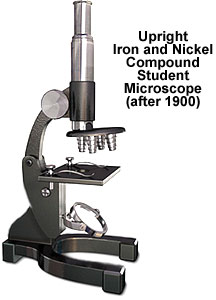Upright Compound Student Microscope
This basic iron and nickel upright compound microscope was useful to students and amateur microscopists alike during the early 1900s. Part of the Billings collection at the Walter Reed Army Hospital in Washington, DC, the unsigned monocular instrument is not attributed to any craftsman, firm, or country.

The body of the microscope is supported by an overly large horseshoe-shaped base and a relatively thin, 1-inch pillar. A pivot between the pillar and the instrument's limb enables an observer to adjust the angle of viewing. The microscope does not feature a substage condenser or aperture diaphragm, but a 0.94-inch diameter mirror is mounted on gimbals below a simple, 2.25-inch square stage that contains a central, round aperture. Rivets hold the stage to the limb of the instrument and a nickel-plated body tube supports a rotatable nosepiece that contains four objectives. A single ocular is seated in the viewing tube, which can be slid in and out of the body tube of the microscope. Coarse focus of the twentieth-century instrument is controlled by a rack and pinion.
BACK TO TWENTIETH CENTURY MICROSCOPES
